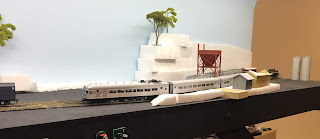I'm a big fan of smaller layouts; less track and fewer baseboards to build means trains are up and running much sooner.
So here we are, three months into the build for this layout and it's progressing just under the pace for Rozelle Street, which I'm taking as a good sign, as this layout has additional turnouts and some new electronic gear added. I've now finished all of the track wiring, and have installed and configured all of the turnout servos.
The most painful installation of Servo's, ever.
I was having some trouble getting the throw to align correctly while fitting most of the servos. I opened out the holes underneath the throw-bars to make things easier, shifted the servos and played around with tweaking the end points of the throw using the decoder, but I was still getting that horrible grinding sound in some cases, and eventually, the white arm just fell off, taking the piano wire out from the turnout with it.
Turns out, I forgot a screw.
Or more accurately, a number of screws. In the picture above there is a screw to hold the plastic arm onto the servo, and another to hold the servo onto the mounting block. I double-checked the instructions and found that it didn't actually identify that a screw was required to hold the arm on. I only learned I was doing it wrong when, frustrated, I took one of the servos over to Rozelle street and compared what I'd done there previously.
For reasons I can't fathom, only two of the servo decoders will display the fascia panel LEDs in the configuration I want to; green for the direction of alignment, red for the closed route. I've tried moving the jumpers around, re-setting the factory settings on the decoders, everything. In the end, the servos work, the points change, the frog polarity changes, and there's power where there needs to be on each road. I've locked the decoders to further adjustments, so job done, moving on.
The first train!
With the completion of wiring I got a train out to test how my concept for operating sessions will work. Being fitted with a keep-alive, the X200 is the most tolerant loco I have to shoddy trackwork, so I probably should have gone and grabbed the 73 class, but this will do for now.
I ran through a sequence of bringing the coal train in and shunting it into the colliery siding. It's nice being able to stand back and enjoy the fruits of your labours! Also, all of the double and triple-checking I'd done for clearances for running around and siting the uncouplers seems to have paid off, with no issues found.
I did discover that I'd forgotten to install an uncoupler on the main to facilitate shunting the coal wagons into the colliery siding, but luckily I have one more uncoupler left, so that will be another job in the near future.
Other developmentsAfter much um'ing and ah'ing I've decided to wire the uncouplers onto an accessory bus, rather than the track bus. Rapido recommends 12V DC with a minimum of 500 mA. I've read in some user reviews that people were needing to use at least a 1 Amp system to get the uncouplers to throw, so I picked up a 12V 1.5 Amp power adaptor from Jaycar, and wired up an example today to see if it worked.
An audible 'clunk' tells you the uncoupler is working once thrown, and mine seems to be working fine with the 1.5Amp solution. Now that that's a proven concept, I'll have to wire up all six of these in due course. Another job for the next few weeks, before we even get to installing them and hooking them up to the accessory bus...
I've also come up with how I want the colliery loading bin to look. The main components will come from the Ratio 547 coaling tower kit, and I've assembled about half of it already, and put it in place to get an idea for the look and feel.
Electric locos won't be permitted under the loading bin, but will still be able to access the branch for shunting and departing from the yard.
I'm happy with it so far, but I'll extend the bin and add a covered conveyor belt from the mine, which will disappear into the rock at the back of the module.
As always, here's the overall view. Adding a few trees and buildings has helped visualise where I want everything to sit, and I'm happy with how it's coming along.
In other news, Auscision has announced that the 85's have arrived in the country and will be sent out within the next fortnight. I probably won't post again until after I've received mine and taken it out of the box for a run. I may also have another addition to show off around the time of the next post, but we'll see. I'm aiming to have the uncouplers and fiddle yard done by September too.
Until next time!
Cheers,
Ben

















































